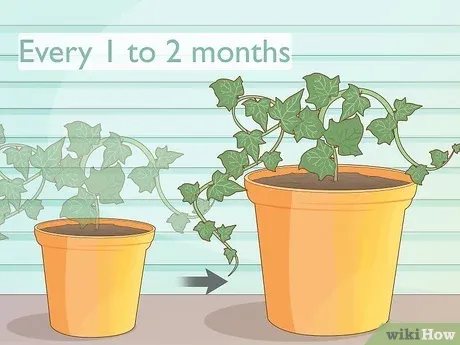A Complete Guide to Propagating English Ivy
English ivy is a popular evergreen climbing vine recognized by its heart-shaped leaves and tendency to creep along surfaces. From maintaining historic ivy-covered buildings to incorporating this versatile plant in the landscape or container gardens, propagating English ivy from cuttings allows gardeners to enjoy its graceful foliage. In this in-depth guide, I’ll share my top tips for rooting ivy cuttings along with answers to common questions.
Taking Ivy Cuttings
- Select healthy mature stems in spring or early summer before the plants begin flowering. New growth works best for rooting.
- Use sharp, clean pruners to cut 4-6 inch lengths just below a leaf node. Remove lower leaves, leaving the top few intact.
- Cut on an angle to increase the surface area for new roots. Keeps stems in a bucket of water until you’re ready to plant.
From my experience, it’s best to take cuttings in the morning when the plant’s hydrated. Stems often wilt quickly on hot afternoons. Be sure to sterilize pruners between cuts to avoid transmitting diseases.
Preparing the Propagation Medium
English ivy cuttings can be rooted in soil, perlite, or a coco peat and vermiculite mix. I find a 1:1 coco peat and perlite blend works well since it retains moisture while allowing good drainage. Fill containers or tray cells and firm the medium before inserting cuttings.
Planting Ivy Cuttings
- Make a hole in the medium slightly deeper than the cutting’s length with a dibble or pencil.
- Gently insert the stem cutting and lightly firm the medium around it.
- Maintain a humid environment – cover trays with plastic wrap or set in a greenhouse.
- Keep the medium moist but not soaked.
I prefer individual cells or small pots to allow careful monitoring of each cutting. Too much water at this stage can cause rot. A warm location with bright, indirect light also helps get cuttings off to a strong start.

Patience is Key with Ivy Cuttings
English ivy is fairly slow to root, taking 4-8 weeks depending on conditions. In my practice, I’ve found rooting hormones aren’t always necessary since ivy is somewhat stubborn. Signs of new growth usually appear before roots are visible.
Rather than digging up cuttings to check too early, I look for firm, plump stems that are taking up water. Once established, rooted cuttings can be potted up or transplanted outdoors once nighttime temps stay above 50 degrees F. Kind of a waiting game but well worth it!
Common Questions about Ivy Propagation
How do I know when cuttings have rooted?
As mentioned, new leaves or stems indicate roots have formed below ground. Gently tugging a rooted cutting shows some resistance compared to an unrooted one.
Is it okay to start cuttings indoors over winter?
Absolutely! I’ve had good results starting cuttings under grow lights or on a sunny windowsill in fall/winter. Just provide the necessary humidity and keep an eye out for pests in a warm indoor environment.

Will cuttings from different ivy types root successfully?
Generally, cuttings from hybrid cultivars like ‘Baltica’ and ‘Needlepoint’ have reliable rooting rates. Always select healthy-looking stems regardless of variety. Occasionally a mutation may not root well.
How long before cuttings can be planted outdoors?
Once cuttings have become established with new growth and a sturdy stem, they can handle typical outdoor spring conditions. Acclimate cuttings gradually to full sun. Sort of monitor the weather forecast before exposing tender new growth to possible late frosts.
I hope these tips help you propagate your own English ivy cuttings successfully! Let me know if any other questions come up along the way. Rooting cuttings definitely becomes easier with practice basically.
Important Steps for Propagating English Ivy
| Step | Details |
|---|---|
| 1. | Choose healthy parent plant with long vines that can be rooted |
| 2. | Use sharp, clean tool to cut 4-6 inch section of vine |
| 3. | Remove lower leaves from cutting to reduce moisture loss |
| 4. | Dip cutting in rooting hormone if desired |
| 5. | Plant cuttings in potting soil, cover top few inches with soil |
| 6. | Mist soil and cuttings daily to encourage root growth |
| 7. | Keep soil moist but not soaked, roots should form within 4-6 weeks |
| 8. | Transplant new plant or share with others once established |
FAQ
-
How do I start propagating english ivy?
To begin propagating english ivy you’ll need a parent plant. Select a long, vine-like stem with roots growing from the nodes (sections between the leaves). Cut the stem below a node using sharp pruning shears.

-
What’s the best time of year to propagate ivy?
Spring and summer are usually best for propagating ivy cuttings. The warmer weather helps the cuttings root faster. However, ivy can be propagated year-round as long as the cuttings are kept in a warm, bright spot indoors with high humidity till roots form.
-
How do I plant an ivy cutting?
Prepare a pot with potting mix or soil and make a slit in the soil about an inch deep. Place the ivy stem cutting into the slit with a node just below the soil surface. Gently pack soil around the stem. Keep the soil moist by misting it regularly till roots are formed, which may take a few weeks.
-
Can I propagate ivy cuttings in water?
You definitely can root english ivy cuttings in water. Place the stems in a glass of water, changing the water every few days to prevent bacteria. Roots may take longer to form compared to soil but it’s a good option for those who want to see the roots develop. Once you see roots, you can transplant the cutting to soil.
-
How long does it take for ivy to root?
English ivy cuttings usually form roots within 2-4 weeks when conditions are suitable. However, it can take somewhat longer, like 5-6 weeks, for roots to develop on cuttings taken in late fall or winter. Keep the soil lightly moist and be patient. Check the soil gently from time to time to see when you notice new tiny roots emerging.

-
Can you propagate ivy from a leaf?
Propagating english ivy from leaf cuttings is not impossible but it has a very low success rate compared to stem cuttings. Leaf cuttings can sometimes grow new plants but it’s seldom reliable. Your best shot is always using a stem segment with a node to ensure good rooting.
-
What conditions does rooted ivy need?
Once your ivy cuttings have developed roots, move them to a spot with bright, indirect light. Keep the soil lightly moist. As the new plant grows, you can move it to progressively sunnier spots. Ivy thrives in average home conditions – it’s not very fussy. Provide a mossy pole or trellis for the vines to climb as it matures.
